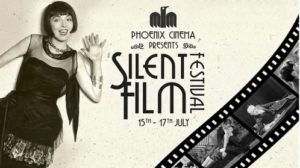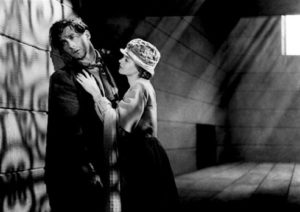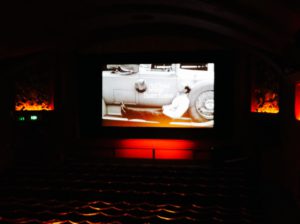Silence still has something to say: Programming a Silent Film Festival at The Phoenix
Miranda Gower-Qian, graduate of our MA Film Programming and Curating, reports on working on the Silent Film Festival at the Phoenix Cinema, 15-17 July 2016.

For many years now I have harboured a great passion for silent cinema, and my interest in film history and heritage has grown with my numerous experiences whilst studying. As part of the MA Film Curating course at Birkbeck, each student spends a month on placement, working with institutions, programmers and curators to further practical understanding of the industry and to gain valuable experience in the respective fields in which we’re interested.
I was fortunate enough to spend my time at the Phoenix Cinema, East Finchley, programming their very first silent film festival – the prospect of which I was quite (or should that be quietly?) excited about. My time at the Phoenix proved to be a most enriching and rewarding experience, as – save from choosing the films – I was given the opportunity to be intimately involved in every stage of building the festival up and learned much about the collaborative processes involved in film programming of this nature.
The first of my responsibilities was to come up with a concept for the poster and marketing materials, which effectively gives the festival a visual identity – a face. I worked closely with the cinema’s graphic designer to create posters, post cards, banners and leaflets, and wrote out a synopsis for each of the films to go on the Phoenix website. I was pleased with the results, however one thing I regret was neglecting to provide programme notes/hand-outs for each of the screenings, as those are always helpful and oft-appreciated, not to mention exemplify a degree of care and consideration for the programme that might otherwise go unnoticed.
Over the course of three days in July, five screening events were held. Three feature films: Sunrise: A Song of Two Humans (F.W. Murnau, 1927), Why Be Good? (William A. Seiter, 1929) and East is East (Henry Edwards, 1916). One children’s educational event: Silent Slapstick with Neil Brand, and a community archive screening led by Prof. Ian Christie.

The Phoenix’s silent journey began on an appropriately sunny Friday evening with F.W. Murnau’s much-loved masterpiece, Sunrise: A Song of Two Humans (1927). This being the festival premiere, we procured musical accompaniment from the talented Stephen Horne and invited Pam Hutchinson of Silent London and a freelance journalist for the Guardian to introduce the film (I introducing her and then she introducing Stephen made for an amusing build up, I thought). I do believe that it’s always enriching to invite relevant professionals and personalities to screening events, as they are always able to bring that infectious cinephile energy and enthusiasm.
 Though immensely enjoyable, it is debateable as to whether live accompaniment is an essential component when screening silent film. What I believe is that it brings a certain sense of intrigue – of prestige, even, as it creates an environment quite separate from the standardised experience of cinema going which audiences are currently accustomed. It’s interesting that it does this whilst simultaneously being reminiscent of the 1910s and 20s, when it was commonplace for cinemas to provide live accompaniment to all of their films. It certainly brought a fresh and spirited energy to the Sunrise screening and stimulated an enthusiastic involvement from the audience – a sensitive flute insinuating a heroine’s heartache, the clatter of symbols bringing thunder to a storm, a slurry accordion giving life to a little drunk piggy (read: the star of the show).
Though immensely enjoyable, it is debateable as to whether live accompaniment is an essential component when screening silent film. What I believe is that it brings a certain sense of intrigue – of prestige, even, as it creates an environment quite separate from the standardised experience of cinema going which audiences are currently accustomed. It’s interesting that it does this whilst simultaneously being reminiscent of the 1910s and 20s, when it was commonplace for cinemas to provide live accompaniment to all of their films. It certainly brought a fresh and spirited energy to the Sunrise screening and stimulated an enthusiastic involvement from the audience – a sensitive flute insinuating a heroine’s heartache, the clatter of symbols bringing thunder to a storm, a slurry accordion giving life to a little drunk piggy (read: the star of the show).
The main purpose of setting up a silent film festival at the Phoenix was to create a platform for younger generations of audiences to see and learn about silent film. Therefore one of the most important and – to my mind – innovative events we programmed was the “Kids Club” educational screening. This screening was particularly important to me, as I believe that it is exactly this sort of programming that might encourage a new interest/understanding of what silent film is and can be.
That, and I’m a shameless fan of anything by Buster Keaton…
 Needless to say Neil Brand set up an arrangement of clips from some of Keaton’s silent shorts. As the clips played, he accompanied them on the piano and gave insight as to how the music works alongside the image in order for the audience to understand what is going on in the action without the spoken words. I thought it was a fascinating and unusual way in which to introduce children to the world of silent film, and in creating that understanding of why there is no need for talking potentially broadens peoples’ perceptions. Therefore it is to wonder whether the future of silent film interest lies within a more substantial link to music…
Needless to say Neil Brand set up an arrangement of clips from some of Keaton’s silent shorts. As the clips played, he accompanied them on the piano and gave insight as to how the music works alongside the image in order for the audience to understand what is going on in the action without the spoken words. I thought it was a fascinating and unusual way in which to introduce children to the world of silent film, and in creating that understanding of why there is no need for talking potentially broadens peoples’ perceptions. Therefore it is to wonder whether the future of silent film interest lies within a more substantial link to music…
As the festival progressed, we wanted to ensure that we were bringing a fresh and energetic vibe to the screenings.  Why Be Good? is a fine example of the Flapper Era of the 1920s, thus a flapper dance performance was organised before the screening and audience members were given a themed cocktail before going into the auditorium. Not necessarily my cup of tea, but it certainly attracted a younger audience – surveys revealed that a lot of young women, in particular, would attend something like this again.
Why Be Good? is a fine example of the Flapper Era of the 1920s, thus a flapper dance performance was organised before the screening and audience members were given a themed cocktail before going into the auditorium. Not necessarily my cup of tea, but it certainly attracted a younger audience – surveys revealed that a lot of young women, in particular, would attend something like this again.
The final afternoon and evening events for the festival were screened on a Sunday and linked with the idea of the Phoenix as community cinema. An archive collection of shorts, featuring films made in London were shown as part of an illustrated talk. It proved a very informative way of showcasing London as a place connected with the origins of film, and acted almost as a time-capsule or an animated tour through time – something that I believe cinema, above all other forms of art, is able to do most fascinatingly.

It is difficult, because I have found that there is a conflict when deciding what the word value means in regard to a film. Some would say that a film’s value is equal to how many tickets it sells, others would argue that it is the quality of the direction and/or the acting that gives the movie its worth. My instinct as a cinephile is to say that it is absolutely the quality of the film that gives it its value – if I believe that any one film is good and interesting and stimulating, then I believe that should be enough to show it and share it with people. However, everyone has his or her own taste and I can see how simply screening what one wants could easily become rather chaotic. Therefore you need to think of the way in which you present films – the context within which you place them – be it within a film programme, a festival, or as a stand alone event, because it is there that you can potentially bring (and justify) value.
What I quickly came to understand was that film programming/curating is not as straightforward as simply choosing a film, screening it and hoping for the best. Far from it. Films should be treated with consideration and, to a certain degree, nurtured in order to continue to exist. I like to think of films as fluid organisms, whereby audiences bring the power that fuels them forward into the world. Without the cultivation of audiences, films can and do tend to freeze in time. Therefore the way in which one presents a film takes careful consideration, as both the physical and vernacular environment you create will essentially affect the way in which a film is received by an audience. This is important to encouraging some form of engagement between films and audiences, something that I have come to understand as an essential part of a film curator’s role in keeping film (silent film, in this particular instance) alive.

